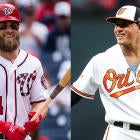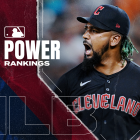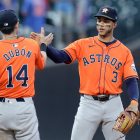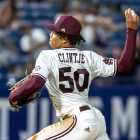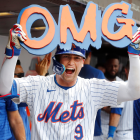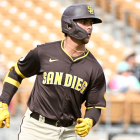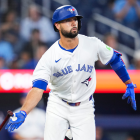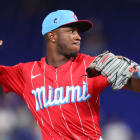While our baseball attention is rightly focused on the still-embryonic playoff races, let's not forget the one to determine who will sign the largest contract in MLB history. We speak, of course, of the pending free agencies of Bryce Harper of the Nationals and Manny Machado of the Orioles.
For a long time, it seemed like a fait accompli that Harper would be the one to top Giancarlo Stanton's $325 million deal by the largest margin. Early in the 2018 season, though, Machado has reasserted himself. Writing in the pages of the New York Post, Joel Sherman recently noted that the race between the two free-agents-to-be is tightening, so perhaps this matter merits a closer look.
First let's acknowledge a couple of facts that won't change when it comes to the case of Harper v. Machado ...
- While both are very young as pending free agents go (their relative youth plus their on-field excellence is why each is going to blow past Stanton's record next winter), Harper is 102 days younger than Machado.
- Harper has the stronger career body of work at the plate (142 career OPS+ to Machado's 119), and there's not time enough for that to change this season.
Those are two important factors will no doubt play in role in determining the market for each player. Again, the very sensible assumption coming into 2018 was that Harper was in line to fetch the larger payday, and that's been the assumption for some time. That was especially the case coming off Machado's disappointing 2017 campaign, in which he batted .259/.310/.471. While we're of course very early in the 2018 season and the usual sample-size caveats apply, things may be changing on this front. Let's explore why that might be the case ...
Machado is a much more valuable defender than Harper is
As noted above, Harper's been the better hitter to date on a raw basis. However, Machado at present has the higher career WAR, by a slim margin of 29.3 to 26.8. To be sure, we can't say Machado's been the better player overall because WAR simply isn't that precise and carries with it a margin for error. But it's closer than you might think if you're just eyeballing each player's numbers at the plate. That's where defense comes in.
Harper's a right fielder these days, and he generally grades out as a solid one. Machado, however, has for years been a standout defensive third baseman, and this season he's moved back to his original position of shortstop. It's too early to pass judgment on Machado's fielding at short, but thus far he's established that he's capable of at least getting by at the most premium position in the field. The fallback plan for his eventual new team? Machado goes back to being in the discussion for best defensive third baseman in the game today. Harper's bat is indeed special, and you can certainly argue that it makes him the better overall player. Machado, though, promises much more value with the glove.
Machado may be in the early stages of a career year at the plate
First, let's note again the small data that is the 2018 season to date. That means there's plenty of time for things to change -- perhaps drastically -- for the better or worse. Anyhow, Harper has been in near-peak form thus far in 2018 ...
Harper's eight homers leads the NL at this writing, and overall that's elite production at the OBP and power levels. He's also drawn 28 unintentional walks against just 16 strikeouts. Also impressive is that Harper has done this despite a .211 BABIP -- a figure that will almost certainly rise the rest of the way.
As for Machado, he's been better than ever by a wide margin ...
We know Harper's capable of these kinds of outputs, but Machado's ankle-deep into what would be a career year and then some. Speaking of BABIP, he's at .343 versus a career mark of .302, so perhaps some regression is in his future. That said, he's struck out just 15 times against 11 unintentional walks. Speaking of Machado's improved plate discipline, consider this ...
Time frame | Machado's swing rate on pitches out of strike zone | Machado's swing rate on pitches in strike zone |
Career | 30.4 percent | 66.9 percent |
2018 | 24.4 percent | 73.5 percent |
That's a hitter who's getting a better idea of which pitch locations he can handle. Also bear in mind that those career figures include his 2018 numbers. As noted, yes, it's early, but these are the kinds of indicators that become meaningful pretty early.
Speaking of becoming meaningful pretty early, consider the following ...
- Machado this season has an average exit velocity off the bat of 91.6 mph, while Harper is at 91.0.
- Machado in 2018 has a top recorded exit velocity of 111.8 mph, while Harper's is 111.5.
- Machado's average batted ball in 2018 has traveled 208 feet, while Harper's figure is 173.
Need more? Machado this season has a fly-ball rate of 51.3 percent versus a pre-2018 figure of 38.1 percent. That huge leap suggests a conscious change in approach or at least an unconscious evolution. Given Machado's tremendous raw power, putting more balls in the air will benefit him.
Machado has earned his hot start
For this one, we'll turn to an advanced metric called expected weighted on-base average (xwOBA). xwOBA grows out of wOBA, which assigns proper value to every possible offensive event that happens while a batter is at the plate. Those proper valuations of singles, doubles, homers, walks, etc., distinguish wOBA from more traditional measures like AVG, OBP, and SLG. Also, for simplicity wOBA is scaled to look like OBP, which means that, for example, .400 is elite and .290 is bad.
All of that brings us back to xwOBA, which is an estimation of what a hitter's wOBA should be based on things like exit velocity off the bat and launch angle. xwOBA attempts to strip away luck -- bad or good -- and defensive play from wOBA and identify a hitter's baseline skill. It's useful for getting an idea of how a hitter figures to perform in the near-term future. Basically, if a hitter's xwOBA is significantly lower than his wOBA, he's probably going to come back to earth at some point. Here's more on wOBA, and here's more on xwOBA.
Insofar as the topic at hand is concerned, here's how our two heroes fare so far ...
Player | 2018 wOBA | 2018 xwOBA |
Machado | .448 | .452 |
Harper | .458 | .423 |
First, each player has -- as you know -- been outstanding in 2018. Harper's underlying indicators, though, indicate he's 35 points over his head. Machado, meantime, has actually underperformed his fundamentals to a slight degree. These, two, are based on inputs that become meaningful pretty early in the season.
Add it all up -- the improved approach at the plate, the upward-trending fly-ball tendencies, and the positive xwOBA outlook -- and it's possible Machado is in the early stages of leveling up at the plate. Finally ...
Machado is less likely to be encumbered by a qualifying offer
The Nationals, while off to a disappointing start, are hellbent on contention in Harper's final year in the fold. He's not going to be traded this season regardless of where the Nats are in the standings leading up to the July 31 non-waiver deadline. Machado's Orioles, meantime, are horrid, were expected to be horrid, and have little hope of not being horrid at any point this season. That plus Machado's walk-year status is why the star infielder is a strong bet to be traded during the 2018 season.
Speaking of which, pending free agents who play for more than one team during said walk year are not eligible to receive a qualifying offer. If Machado is indeed dealt -- which seems likely -- then he won't be saddled with a qualifying offer. To be sure, no serious bidder is going to back off the likes of Harper or Machado because of the loss of draft picks (a wrinkle in the QO system designed to tamp down free agent costs), but that reality will be reflected in the market for the two players' services. Harper is going to receive a qualifying offer, but Machado might not.
Next offseason, Machado and Harper are going to sign (one of them with the Phillies, it says here), and combined the two will be guaranteed almost $1 billion. For a long time, the assumption has been that Harper would be the more richly rewarded of the two, but Machado in the early weeks of the 2018 season has flipped the script. Expect to be flipped another time or three before pen gets put to paper next offseason.













